How to Decorate your Bedroom in Neutral Colors
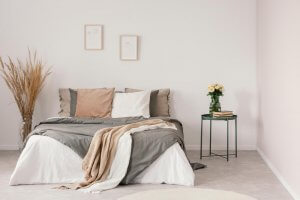
In interior decor, when we talk about neutral colors, we’re basically talking about tones with very little color at all. Neutral colors are the polar opposite of bright, vibrant shades. This is a color palette that inspires a sense of balance and tranquillity, making it a great choice for bedrooms.
Plus, it’s also really fashionable at the moment and doesn’t seem to be going anywhere any time soon. While any room can benefit from a neutral color scheme, the bedroom is perhaps the best place to recreate that feeling of balance we all crave when we get home from a long day at work.
In fact, decorating your bedroom in neutral colors could actually help you to get a better night’s sleep, promoting feelings of security and serenity. But which colors can you actually use in neutral decor?
Today, we want to move away from the classic vanilla-colored bedroom walls that have been practically mandatory over the past few years. There is a huge range of neutral colors to choose from, so you can play around with them until you find the perfect combination. Bedrooms also offer a number of surfaces for you to work with, allowing you to apply your chosen colors in a variety of different ways.
Neutral colors – let’s start with the floor
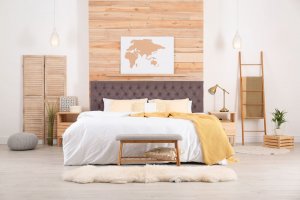
Bedroom floors are often already neutral in color. Wooden or ceramic floors in colors such as marble or earth tones give us a great base upon which we can start building our neutral bedroom decor.
With this in mind, we recommend starting at floor level, and slowly working your way up. A soft, thick rug is a must-have item in any bedroom and gives you the first opportunity to start adding neutral colors to your design.
Natural fiber rugs (like jute or sisal) are perfect for bedrooms. If you want to give your room a warm and welcoming feel, we would suggest buying a wool rug, choosing soft tones such as stone, gray, taupe, white, beige or cream.
Try to look for subtle tones with great potential. While you could choose a small rug, placing a larger rug at the foot of your bed will have more impact. If you really want to stand out, you could even lay wall-to-wall carpeting instead.
Neutral colors – bedroom walls
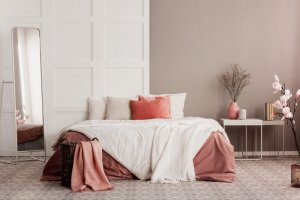
Now that you have your floor as a base, you can start working on the walls. Start by taking a look at any architectural features in the room, such as baseboards, cornices or architraves.
In the world of interior decor, the ceiling is seen as an extension of the walls, so you’ll also need to think about features such as ceiling beams.
Plan out your color scheme, deciding how many tones you want to use, and where you want to use them. Using more than one shade of the same or different colors will add depth and strength to your room. Remember to include the ceiling in this color scheme, rather than simply leaving it white.
Neutral-colored furniture
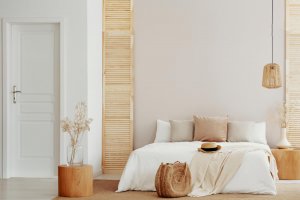
Furniture can act as a fantastic source of inspiration, allowing you to explore a variety of shapes and materials. Wooden furniture is perfect for neutral bedrooms. However, you could also use paint to create a similar effect on other materials.
Mirrors are another great resource for neutral bedrooms, whether on the walls or incorporated into your furniture. Mirrored nightstands, closets and dressers are ideal for this kind of decor.
Neutral bedrooms – fabrics
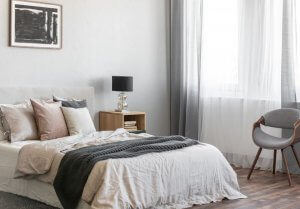
Textiles are the stars of any bedroom. In fact, the bedroom is the area of the house with the highest concentration of fabrics and upholstery. Curtains, duvets, blankets, and pillows open up new opportunities to add more neutral tones.
It’s also important to remember that textiles offer us the chance to play around with texture. Having a variety of different textures creates a rich visual tapestry that makes our rooms so much more interesting to look at.
Try mixing textures such as satin and silk with luxurious velvet or mohair. Faux furs can also be a great option for neutral bedrooms.
Why not incorporate faux snakeskin upholstery or, for a more understated look, small details and accessories? There’s a whole world of soft and relaxing colors to choose from.
In interior decor, when we talk about neutral colors, we’re basically talking about tones with very little color at all. Neutral colors are the polar opposite of bright, vibrant shades. This is a color palette that inspires a sense of balance and tranquillity, making it a great choice for bedrooms.
Plus, it’s also really fashionable at the moment and doesn’t seem to be going anywhere any time soon. While any room can benefit from a neutral color scheme, the bedroom is perhaps the best place to recreate that feeling of balance we all crave when we get home from a long day at work.
In fact, decorating your bedroom in neutral colors could actually help you to get a better night’s sleep, promoting feelings of security and serenity. But which colors can you actually use in neutral decor?
Today, we want to move away from the classic vanilla-colored bedroom walls that have been practically mandatory over the past few years. There is a huge range of neutral colors to choose from, so you can play around with them until you find the perfect combination. Bedrooms also offer a number of surfaces for you to work with, allowing you to apply your chosen colors in a variety of different ways.
Neutral colors – let’s start with the floor

Bedroom floors are often already neutral in color. Wooden or ceramic floors in colors such as marble or earth tones give us a great base upon which we can start building our neutral bedroom decor.
With this in mind, we recommend starting at floor level, and slowly working your way up. A soft, thick rug is a must-have item in any bedroom and gives you the first opportunity to start adding neutral colors to your design.
Natural fiber rugs (like jute or sisal) are perfect for bedrooms. If you want to give your room a warm and welcoming feel, we would suggest buying a wool rug, choosing soft tones such as stone, gray, taupe, white, beige or cream.
Try to look for subtle tones with great potential. While you could choose a small rug, placing a larger rug at the foot of your bed will have more impact. If you really want to stand out, you could even lay wall-to-wall carpeting instead.
Neutral colors – bedroom walls

Now that you have your floor as a base, you can start working on the walls. Start by taking a look at any architectural features in the room, such as baseboards, cornices or architraves.
In the world of interior decor, the ceiling is seen as an extension of the walls, so you’ll also need to think about features such as ceiling beams.
Plan out your color scheme, deciding how many tones you want to use, and where you want to use them. Using more than one shade of the same or different colors will add depth and strength to your room. Remember to include the ceiling in this color scheme, rather than simply leaving it white.
Neutral-colored furniture

Furniture can act as a fantastic source of inspiration, allowing you to explore a variety of shapes and materials. Wooden furniture is perfect for neutral bedrooms. However, you could also use paint to create a similar effect on other materials.
Mirrors are another great resource for neutral bedrooms, whether on the walls or incorporated into your furniture. Mirrored nightstands, closets and dressers are ideal for this kind of decor.
Neutral bedrooms – fabrics

Textiles are the stars of any bedroom. In fact, the bedroom is the area of the house with the highest concentration of fabrics and upholstery. Curtains, duvets, blankets, and pillows open up new opportunities to add more neutral tones.
It’s also important to remember that textiles offer us the chance to play around with texture. Having a variety of different textures creates a rich visual tapestry that makes our rooms so much more interesting to look at.
Try mixing textures such as satin and silk with luxurious velvet or mohair. Faux furs can also be a great option for neutral bedrooms.
Why not incorporate faux snakeskin upholstery or, for a more understated look, small details and accessories? There’s a whole world of soft and relaxing colors to choose from.







